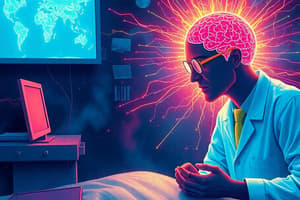Podcast
Questions and Answers
What does ECT stand for?
What does ECT stand for?
- Electroconvulsive therapy (correct)
- Electrocardiographic therapy
- Electromagnetic cranial technique
- Electrical cognitive treatment
ECT is used to treat what condition?
ECT is used to treat what condition?
depression
ECT is the first resort to treat depression.
ECT is the first resort to treat depression.
False (B)
Besides depression, ECT can also be used to treat what?
Besides depression, ECT can also be used to treat what?
How does ECT induce seizures in patients?
How does ECT induce seizures in patients?
How does ECT cause seizures?
How does ECT cause seizures?
How can ECT be performed?
How can ECT be performed?
Which side is referred to when mentioning unilateral ECT?
Which side is referred to when mentioning unilateral ECT?
What does bilateral ECT imply?
What does bilateral ECT imply?
Which type of ECT is more effective but has worse side effects?
Which type of ECT is more effective but has worse side effects?
How much electrical impulse is sent to the brain during ECT?
How much electrical impulse is sent to the brain during ECT?
Patients undergoing ECT have their whole body flapping.
Patients undergoing ECT have their whole body flapping.
What is seen with a patient undergoing ECT?
What is seen with a patient undergoing ECT?
How long do seizures last during ECT?
How long do seizures last during ECT?
Name two medications given to patients undergoing ECT.
Name two medications given to patients undergoing ECT.
What does atropine do in the context of ECT?
What does atropine do in the context of ECT?
What can stimulating the vagal response cause?
What can stimulating the vagal response cause?
What is the purpose of administering anectine during ECT?
What is the purpose of administering anectine during ECT?
What is a contraindication for ECT?
What is a contraindication for ECT?
List five risk factors for ECT.
List five risk factors for ECT.
What are three risks associated with ECT?
What are three risks associated with ECT?
Before performing ECT, what four assessments are needed?
Before performing ECT, what four assessments are needed?
When is ECT usually performed?
When is ECT usually performed?
What are the requirements the night before ECT?
What are the requirements the night before ECT?
What should be done before performing ECT?
What should be done before performing ECT?
During ECT, a tube is placed in the trachea to help with breathing, and restraints are used, performed in an operating room.
During ECT, a tube is placed in the trachea to help with breathing, and restraints are used, performed in an operating room.
How often is a single dose of ECT given?
How often is a single dose of ECT given?
On what days is ECT usually performed if a single dose is given?
On what days is ECT usually performed if a single dose is given?
What should be monitored post ECT?
What should be monitored post ECT?
What test is performed before the ECT procedure?
What test is performed before the ECT procedure?
What does the CARROLL test assess?
What does the CARROLL test assess?
Flashcards are hidden until you start studying
Study Notes
Electroconvulsive Therapy (ECT)
- ECT stands for electroconvulsive therapy, a medical treatment primarily for mood disorders.
- It is primarily used to manage severe depression and can also treat bipolar disorder and mania.
- ECT is not a first-line treatment for depression; it is considered a last resort when other treatments fail.
Procedure and Mechanism
- During ECT, seizures are induced in the patient by placing electrodes on the temporal area of the head while the patient is under anesthesia.
- Electrical impulses sent to the brain reset its electrical activity, causing seizures that typically last 30-60 seconds.
- ECT can be administered in two ways: unilaterally (on the right side) or bilaterally (across the whole brain).
- Bilateral ECT is more effective but associated with more severe side effects compared to unilateral ECT.
Safety and Monitoring
- Safety precautions prior to ECT include completing a baseline EKG, basic blood tests, urinalysis, and chest X-ray.
- Patients should be NPO (nothing by mouth) after midnight the night before the procedure and avoid medications.
Medications Used
- Before the procedure, patients receive atropine to reduce secretions and prevent aspiration risk.
- Anectine, a muscle relaxant, is also administered to prevent spasms during the procedure.
Risks and Contraindications
- Major contraindications for ECT include increased intracranial pressure (ICP).
- ECT carries risks such as death, permanent memory loss, and potential brain damage.
- Risk factors that increase complications include recent myocardial infarction, cardiac arrhythmias, aneurysms, glaucoma, and respiratory infections.
Treatment Schedule
- A typical treatment schedule for single-dose ECT involves three sessions a week for three weeks, totaling nine treatments.
- These sessions are usually performed on Monday, Wednesday, and Friday.
Post-Procedural Care
- Post-ECT care involves monitoring vital signs, positioning the patient on their side, orienting the patient, and providing reassurance post-anesthesia.
- There is a common misconception that patients undergoing ECT experience full-body flapping movements; in reality, only one extremity may move due to IV medications controlling the seizures.
Memory Evaluation
- The CARROLL test, performed before the procedure, assesses memory loss by asking specific questions about the patient's memory retention.
Studying That Suits You
Use AI to generate personalized quizzes and flashcards to suit your learning preferences.




